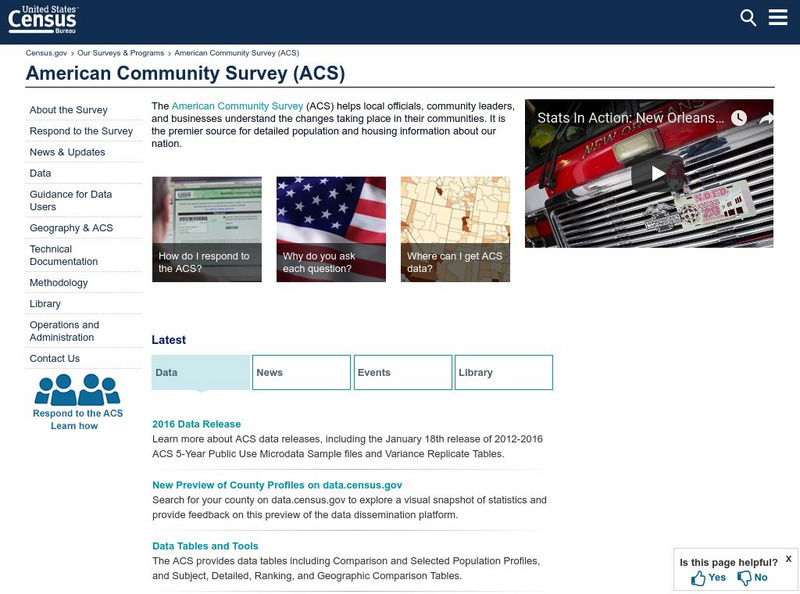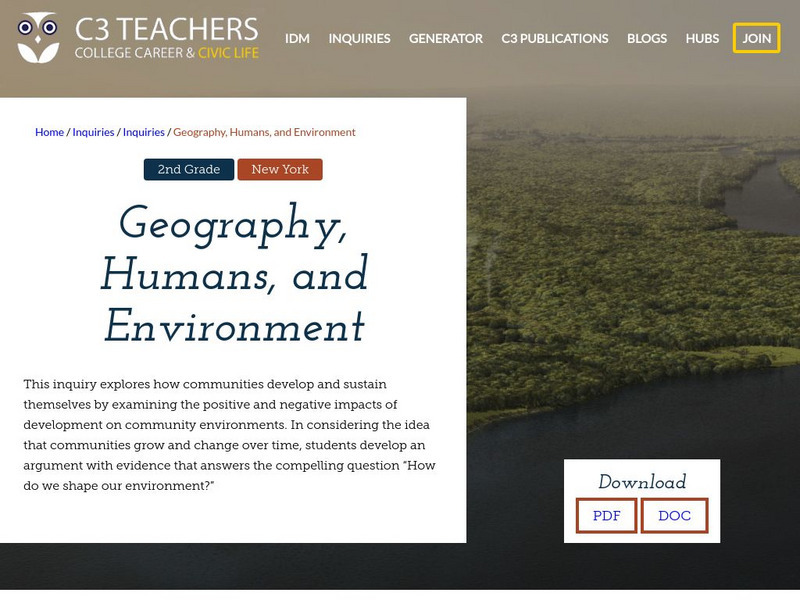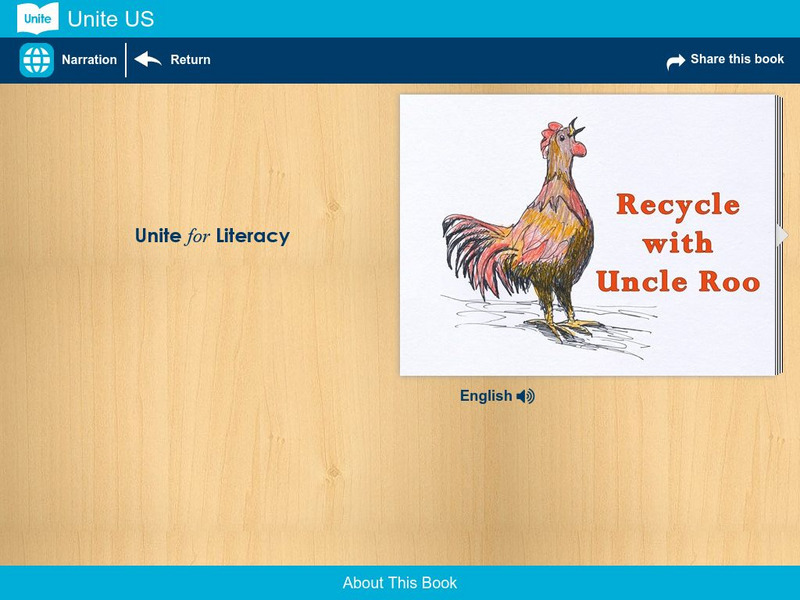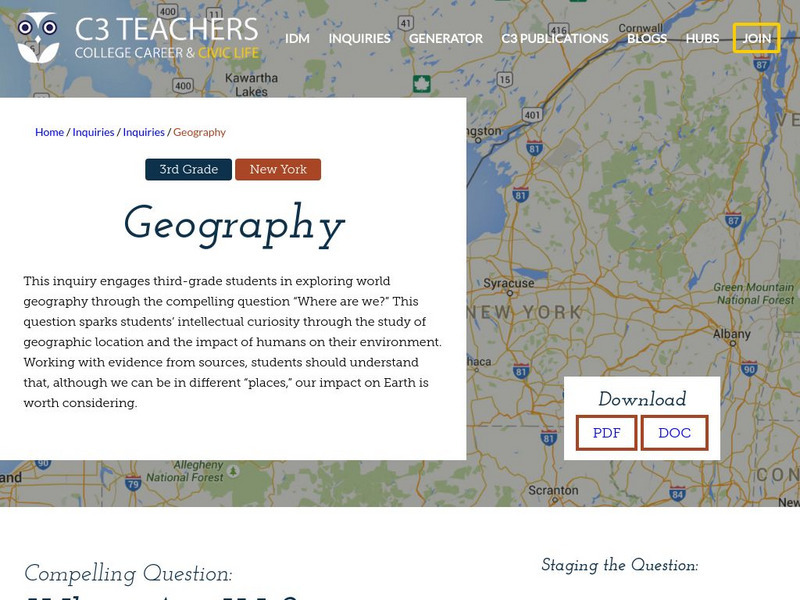Hi, what do you want to do?
Curated OER
Discovering the Past Using the Future: Remote Sensing and the Lost City of Ubar
Students use a video, maps, worksheets and Internet research to explore the role that sensing played in locating Ubar - the lost city of Arabia.
Curated OER
How Did That Get There?
Students evaluate the role of government in addressing land use and other environmental issues. They analyze the powers, responsibilities, and limitations of elected and appointed officials in the national legislative, executive, and...
Curated OER
Raw Materials
Students participate in a nature hike and record the natural resources observed. They compare traditional and modern versions of everyday use items, and create graphic organizers that demonstrate the interconnectedness of resources.
Curated OER
River Study
Students study physical features of a local stream. They study how to identify water features on topographic maps.
Curated OER
Making Sense of the Census
In this unit of lessons, learners make sense of the Census. They examine why a census is taken and participate in activities.
Curated OER
Where's the Barbecue?
Young scholars identify the major landforms, regions and rivers on a map of South Carolina. They compare the locations of the major Native American groups in the state as well. They chart where barbecue restaurants are located and write...
Curated OER
Habitat Lap Sit
Fourth graders physically form a circle that shows the interconnectedness of the components of a habitat. They form circles and role play the parts of habitats.
Curated OER
Government Lesson Plan 15
Students practice planning for the development of an area using the goals of Smart Growth as a guide, and analyze how regions can affect government policies.
Curated OER
Don't Water....Shed A Tear#145
Students examine the definition and attributes of tributaries and watersheds. They design a landscape which includes a mountain, a river, a lake and other appropriate items. They observe as the teacher pours water through the landscape...
Curated OER
Ani-mania
Learners view and discuss Robert Harris' farm landscapes and create their own mural out of wood. In groups, they discuss various issues affecting pets throughout the world and create a way to protest or celebrate the issue. They try to...
Curated OER
Wild Waters Downtown
Fourth graders investigate how wild animals living in urba settings also need sources of clean water. They discuss the open water issues of West Nile Virus and what happens to urba animals as these poolings area are cleaned up. ...
Curated OER
Wat-er We Good For?
Fifth graders investigate the use of water as a resource that needs to be conserved. They practice the skill of water conservation by taking a home survey of water usage and modify the use in order to decrease the wasting of water.
Curated OER
Survey on Climate Change
In this climate change learning exercise, students read through the sentences and answer the questions that survey them about their knowledge of climate change.
Curated OER
The Basics:Life Science
Students explore concepts in life science using segments drawn from Discovery Channel. In this life science lesson, students participate in discussions about the food chain. Students create a poster to illustrate a predator and...
Curated OER
Castles and Forts of Wales and Oregon
Students compare a castle in Wales to a fort in Oregon and design and build a castle or fort. In this structure study lesson, students complete activities to study castles in Wales to forts in England. Students then design their own fort...
Curated OER
Make an Edible Coral Reef
Students create an edible coral reef out of food and candy. In this Science lesson, students explore what a coral reef is and the coral reef's importance to the ecosystem. Additionally, students discover the different parts of a...
US Census Bureau
Us Census Bureau: American Community Survey
The American Community Survey uses demographic data to enable the government and communities make important decisions.
C3 Teachers
C3 Teachers: Inquiries: Geography, Humans, and Environment
A learning module on how humans change and shape their local environment. It includes several supporting questions accompanied by formative tasks and source materials, followed by a summative performance task. Topics covered include...
Unite for Literacy
Unite for Literacy: Community: Recycle With Uncle Roo
See how trash thrown carelessly away affects animals and the environment. Uncle Roo, a rooster, reminds us of why it is important to recycle and reuse. Includes audio narration in English and Spanish with text in English.
TeachEngineering
Teach Engineering: Environment
Through 10 lessons and more than 20 hands-on activities, students are introduced to the concept of an environment and the many interactions within it. As they learn about natural and human-made environments, as well as renewable and...
Environmental Education for Kids
Eek!: Community Action & Citizen Science: Biomonitoring
Biomonitoring is the term scientists use to describe the use of plants, animals, or entire ecosystems to tell if our environment is polluted. Biomonitoring has been used by biologists and scientists to give us information about our...
Texas A&M University
Kinder Garden: Community Gardens
Many urban communities have learned to use unlikely places to develop gardens. At this site visit a community garden and learn how some people have adapted to the limitations of their environment.
Government of Canada
Community Noise Annoyance
Health Canada looks at the issue of excessive and annoying community noise and its effects on people's quality of life. Background on the problem is outlined, followed by a discussion on how highly annoying environment noise can affect...
C3 Teachers
C3 Teachers: Inquiries: Geography
A learning module on world geography. It includes several supporting questions accompanied by formative tasks and source materials, followed by a summative performance task. Students investigate where their community is located, where...



























